AUDI S3 2009 Workshop Manual
Manufacturer: AUDI, Model Year: 2009, Model line: S3, Model: AUDI S3 2009Pages: 324, PDF Size: 76.02 MB
Page 51 of 324
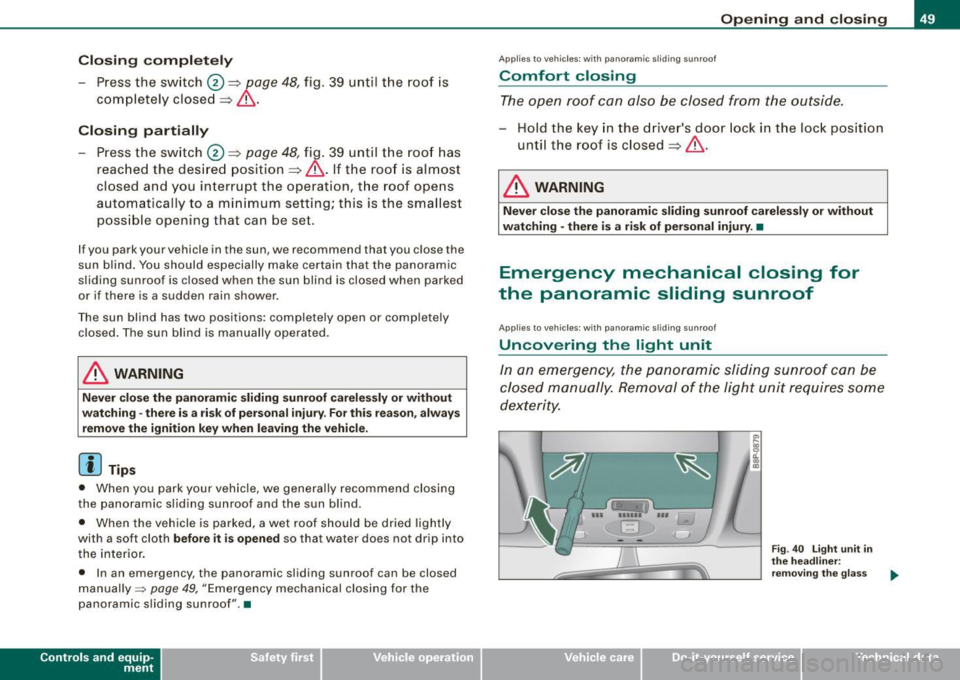
Closing complete ly
- Press the sw itch 0 ~ p age 48, fig . 39 until the roof is
completely closed
~ & .
Closing partially
- Press the sw itch 0 ~ page 48, fig. 39 until the roof has
reac hed the des ired position~ &. If the roof is almost
closed and you interrupt the operation, the roof opens
automatically to a min imum setting; this is the smallest
possible opening that can be set.
If you park your vehicle in the sun, we recommend that you c lose the
sun b lind . You should especially make certain that the panoramic
s liding sunroof is c losed when the sun blind is closed when parked
or if there is a sudden rain shower.
The sun blind has two positions : completely open or completely
closed . The sun blind is manually operated.
& WARNING
Never clo se the pan oramic sliding sunroof careless ly or wi thout
wa tc hing -th ere i s a ri sk of per son al injur y. For t his re aso n, a lways
remove the ignit ion ke y wh en l eav ing the vehi cle.
[ i ) Tips
• When you park your vehicle, we genera lly recommend closing
the panoramic sliding sunroof and the sun blind.
• When the vehicle is parked, a wet roof shou ld be dried light ly
with a soft cloth
before it is op ened so that water does not drip into
the interior .
• In an emergency , the panoramic sliding sunroof can be closed
manually ~
page 49, "Emergency mechan ical closing for the
panoramic sliding sunroof".•
Contro ls and eq uip
ment
Op ening and clo sing
Ap plies to vehicles: wi th panoramic sliding sunroof
Comfort closing
The open roof can also be closed from the outside.
- Hold the key in the driver's door lock in the loc k position
until the roof is closed ~& .
& WARNING
Never clo se the panor ami c sliding su nroof careles sly or without
wat ching -ther e is a r isk of p ers onal injury. •
Emergency mechanical closing for
the panoramic sliding sunroof
App lies to veh icles: with panoramic s liding sun roof
Uncovering the light unit
In an emergency, the panoramic sliding sunroof can be
closed manually. Removal of the light unit requires some
dexterity.
--- '!!ii '-,-.. ---i
EJ
Vehicle care I I
~ 0:. CD
th e head line r:
re m ov ing t he g lass
Technical data
Page 52 of 324
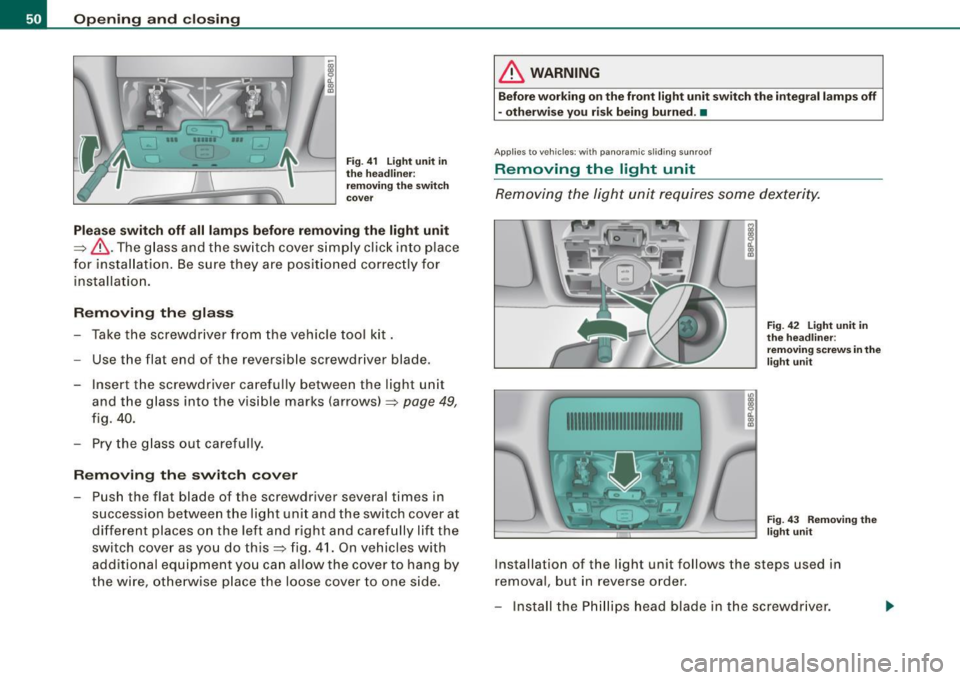
Opening and closing
Fig. 41 Light unit in
the headliner:
removing the switch
cover
Please switch off all lamps before removing the light unit
=>& .The glass and the switch cover simply click into place
for insta llation. Be sure they are positioned correctly for
installa tion.
Removing the glass
Take the screwdriver from the vehicle tool kit.
- Use the flat end of the reversible screwdriver blade.
- Insert the screwdriver carefully between the light unit
and the glass into the visible marks (arrows) => page
49,
fig . 40.
- Pry the glass out carefully.
Removing the switch cover
Push the flat blade of the screwdriver several times in
succession between the light unit and the switch cover at
different places on the left and right and carefully lift the
switch cover as you do this::::> fig. 41. On vehicles with
additional equipment you can allow the cover to hang by
the wire, otherwise place the loose cover to one side.
& WARNING
Before working on the front light unit switch the integral lamps off
- otherwise you risk being burned . •
Appl ies to vehicles : with panoramic s lidi ng sunroof
Removing the light unit
Removing the light unit requires some dexterity.
1111111111111111111111111111111
Fig. 42 Light unit in
the headliner :
removing screws in the
light unit
Fig . 43 Removing the
light unit
Installation of the light unit follows the steps used in
removal, but in reverse order.
- Insta ll the Phillips head blade in the screwdriver.
Page 53 of 324

- Turn the two screws in the light unit in a counter -clock
wise direction to remove=>
page 50, fig. 42.
- Pull the light unit out of the headl iner by the front end
(arrow) =>
page 50, fig. 43.
- Allow the light unit to hang by the wire. •
Applies to vehicl es: wit h pano ra mi c sl idi ng sunroof
Closing the open sky roof manually
Fig . 44 Left end face of
the instrument panel:
fuse cover with hand
crank
Fig . 45 light unit in
the headliner : crank for
emergency operation
You can close the panoramic s liding sunroof using the hand
c rank located o n the inside of the fuse box cover.
- Install the flat blade in the screwdriver .
Contro ls and eq uip
ment
Opening and closing
-Use the screwdriver to remove the fuse box cover
=> fig. 44.
- Remove the crank from the fuse box cover.
- Remove the blade from the screwdriver handle.
- Install the end of the screwdriver handle onto the short
side of the crank to help you turn it=> fig. 44
G).
- Push the long end of the crank@=> fig. 45 all the way
into the hexagonal hole@.
- Hold the crank down and turn it with the screwdriver handle to close the roof.
- Install the light unit first and then the glass. For installa
tion, reverse the removal sequence.
- Return the crank to its location in the fuse box cover
=> fig. 44 and install the cover .
- Have the problem corrected.
[ i] Tips
• To turn the crank for em ergency closing more easily , you should
use the screwdriver handle as an aid. First , remove the screw driver
from th e handl e, th en push the handle onto the crank .
• The crank should be turned slowly; turning it quickly only
incr eas es th e ef fort r equired .•
Vehicle care I I irechnical data
Page 54 of 324
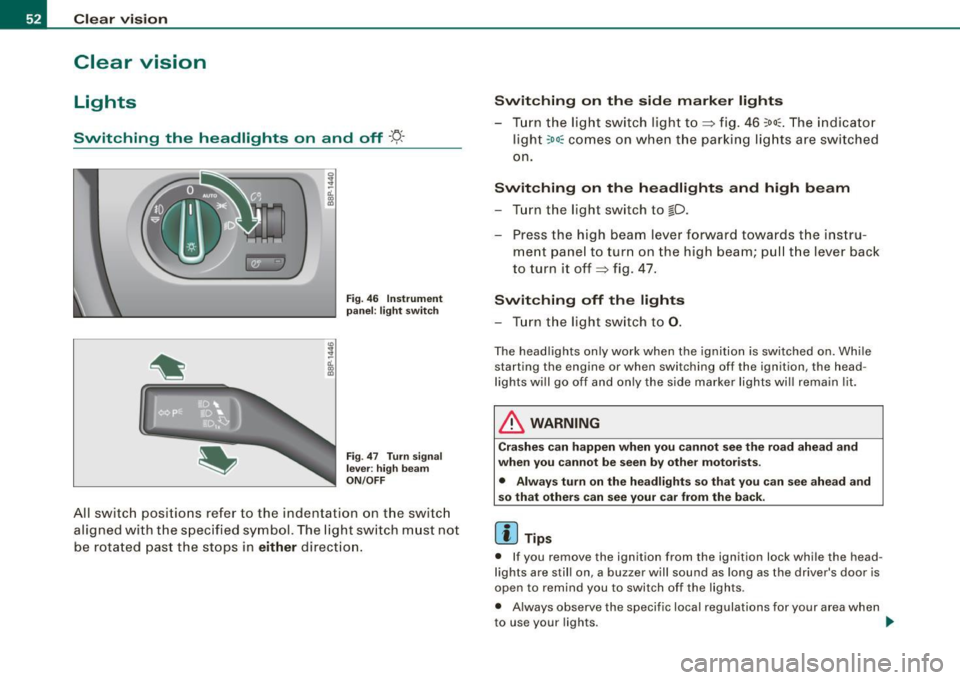
Clear vision
Clear vision
Lights
Switching the headlights on and off ·t/.·
3
-ti. ID
pa nel: li ght switch
F ig .
47 T urn sign al
l e v er: high b eam
ON /OFF
All sw itch positions refer to the indentation on the sw itc h
aligned with the spec ified symbol. The light switch must not
be rotated past the stops in
either direction .
Switching on the side mark er lights
- Tur n the light switch light to~ fig . 46 ~oo~ . The indicator
ligh t
~oo~ comes on when the parking lig hts are switched
on .
Switching on th e he adl ights and high be am
- Turn the light switch to lD.
- Press the high beam lever forward towards t he instru-
ment panel to turn on the high beam; pul l th e lever back
to turn it off~ fig. 47.
Switching off th e lights
- Tu rn the light switch to 0.
The head lights on ly work when the ignition is switched on. Whi le
starting the engine or when switching off the ignition , the head
l ights wi ll go off and only the side marker lights wi ll remain lit.
& WARNING
Cr as hes c an happen when you cannot see the r oad ahe ad and
whe n you cannot be s een by other motor ists.
• Alwa ys tu rn on the headligh ts so th at you ca n see ahe ad an d
s o that others can see your car from the back .
[ i ] Tips
• If you remove the ignition from the ignition lock while the head
lights are still on, a buzzer will sound as long as the driver 's door is
open to remind you to switch off the lights .
• Always observe the specif ic local regulations for your area when
to use your lights .
~
Page 55 of 324

• In cool or damp weather conditions the headlights may fog over
temporarily on the inside.
- The critical factor is the temperature difference between the
interior and the exterior of the headlight lens.
- With the main beams switched on, the light -emitting area will
be free of condensation after a short time, however the edges of
the glass may still be fogged .
- The rear lights and turn signals may also be affected.
- This physical phenomenon has no effect on the life of your
vehicle's lighting system .•
A pplies to vehic les : wit h ligh t sens or p ack age
Sensor activated head- and tail light control
In the "AUTO" position light sensors switch the head- and
tail lights on and off.
Fig. 48 Instrument
panel : light switch in
AUTO position
The sensor-activated low beams have the same characteris
tics as the headlights ~
page 52.
Activating
-Tur n t he light switch ~ fig . 48 to position AUTO.
Con tro ls and eq uip
ment
Clear vision
Deactivating
- Turn the light switch to position 0.
In the switch position AUTO the automatic head-and taillight
control
is activated. The corresponding symbol on the light switch
is lit.
With automatic headlights, the high -beam function is also available,
but with one restriction: If you have not switched the high beams
back to low beams during automatic headlight operation (for
examp le, after driving through a tunnel), only the low beams come
on the next time automatic headlights are switched on . To use the
high beams, you first have to pull the high beam lever back and then
push the lever forward again .
Parking lights, headlights, fog lights and the rear fog light can be
switched on manually using the light switch=>
page 52 .
Light sensors located in the inside mirror housing and stem
constantly check the light conditions surrounding the vehicle. If
ambient brightness falls below a factory set value (e .g . when driving
into a tunnel), the head-and taillights including the license plate
illumination are automatically turned on . When ambient br ightness
increases again, the external lights are turned off again=>
If:::..
Light sensor malfunction
If there is a light sensor malfunction, the symbol comes on in the
display. For safety reasons, the low beams are turned on perma
nently with the switch in
AUTO. However, you can continue to turn
the ligh ts on and off using the light switch . Have the light sensor
checked as soon as possible at a dealership.
& WARNING
• Automatic head -and taillight control is only intended to assist
the drive r. This feature does not relieve the driver of his responsi
bility to check the headlights and to turn them on manually
according to the current light and visibility conditions. For
example, fog and rain cannot be detected by the light sensors. .,
Vehicle care I I irechnical data
Page 56 of 324

Clear vision
& W ARNIN G (con tinued )
Conseq uently , alwa ys swit ch the headl ights i o on under these
weather condition s and when driving in the da rk .
• Cra she s ca n happen when you c annot see the road ahe ad and
when you c annot be seen by other motori sts .
• Alway s turn on the headlights so that you c an see ahead and
s o that ot hers can see you r ca r from the back.
[ i ] Tips
• In the AUTO mode, the low beams are turned off when the igni
tion is turned off. The remaining l ights are turned off when the key
is taken out of the igni tion lock.
• Do not attach stickers to the windshie ld in front of the sensors as
this can disable the automatic head- and tail light control and the
automatic glare -dimming of the rearview mirror(s) .
• Always observe the specific local regulations for your area when
to use your lights .
• In the event of a light sensor malfunction , the driver information
display will show the symbol . If a ligh t sensor malfunction is indi
cated, you must use the light switch to turn the low beams on and
off. •
App lies to t he market: USA mode ls
Applies to vehicles: with daytime ru nni ng lights and bi-xeno n ligh ts
Daytime running lights (DRL)
The daytime running lights are turned on autom atically
when the ignition is switched on .
®r @'
Activating functions
F ig . 4 9 Swit ch for
d ayt ime running li ghts
- Move the r ight thum bwhe el @ "DRL" =} fig. 49 to posi-
tio n
G).
Deactivating functions
- Move t he r ig ht thum bwhee l "DRL" to po siti on @ .
The day time running lights ca n be turned on or off using this func
tion. If the function is active, the daytime running lights are turned
o n aut omatically when the ignition is switched on.
The daytime running lights are activated
only when the light switch
=> fig . 49 @ is at the O or AUTO* posi tion.
& WARNING
Never u se dayt ime running light s to see where you are goin g. They
are not bright enough and will not let you see far e nough ahead for
safety , especially at dusk or when it is dark. Be aware of change s _..
Page 57 of 324
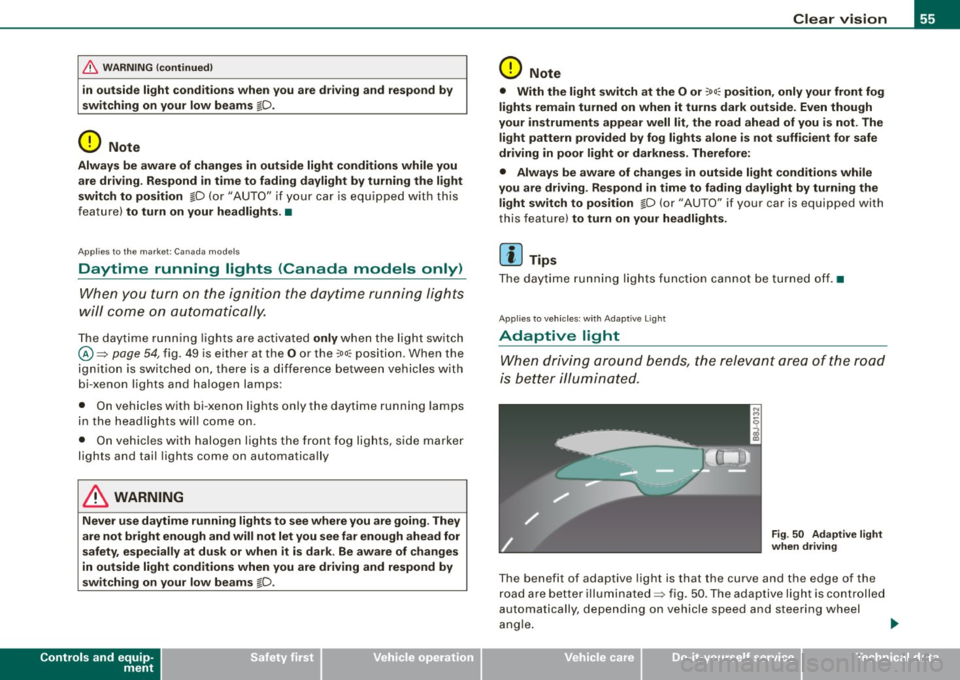
& WARNING (continued)
in outside light conditions when you are driving and respond by
switching on your low beams
io.
0 Note
Always be aware of changes in outside light conditions while you
are driving . Respond in time to fading daylight by turning the light
switch to position
io (or "AUTO" if your car is equipped with this
feature)
to turn on your headlights. •
Applies to the market: Canada models
Daytime running lights (Canada models only)
When you turn on the ignition the daytime running lights
will come on automatically.
The daytime running lights are activated only when the light switch
@=> page 54, fig . 49 is either at the O or the ;oo:c position. When the
ignition is switched on, there is a difference between vehicles with
bi-xenon lights and halogen lamps :
• On vehicles with bi -xenon lights only the daytime running lamps
in the headlights will come on .
• On vehicles with halogen lights the front fog lights, side marker
lights and tail lights come on automatically
& WARNING
Never use daytime running lights to see where you are going. They
are not bright enough and will not let you see far enough ahead for
safety, especially at dusk or when it is dark. Be aware of changes
in outside light conditions when you are driving and respond by
switching on your low beams
io.
Controls and equip
ment
Clear vision
0 Note
• With the light switch at the O or ooo:c position, only your front fog
lights remain turned on when it turns dark outside. Even though
your instruments appear well lit, the road ahead of you is not. The light pattern provided by fog lights alone is not sufficient for safe
driving in poor light or darkness. Therefore:
• Always be aware of changes in outside light conditions while
you are driving. Respond in time to fading daylight by turning the light switch to position
io (or "AUTO" if your car is equipp ed with
this feature)
to turn on your headlights.
[ i] Tips
The daytime running lights function cannot be turned off.•
Applies to vehic les : w ith Ada ptive ligh t
Adaptive light
When driving around bends, the relevant area of the road
is better illuminated.
Fig . 50 Adaptive light
when driving
The benefit of adaptive light is that the curve and the edge of the
road are better illuminated=> fig . 50 . The adaptive light is controlled
automa tically , depending on vehicle speed and steering wheel
angle. _,,,,
I • •
Page 58 of 324
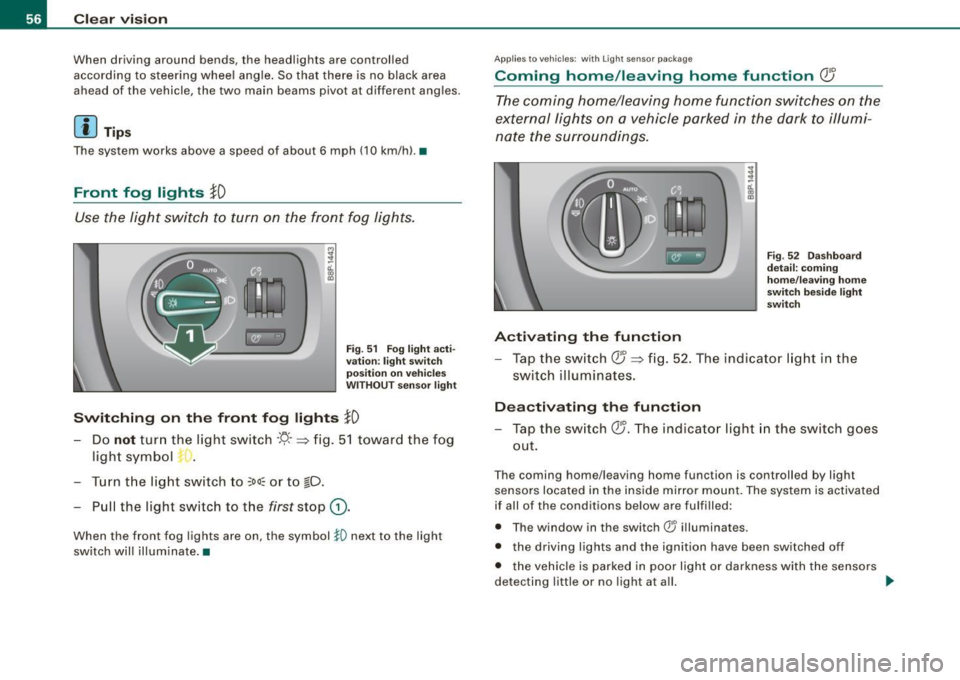
Clear vision
When driving around bends, the headlights are controlled
according to steering whee l angle . So that there is no black area
ahead of the vehicle, the two main beams pivot at d ifferent ang les .
[ i ) Tips
The system works above a speed of about 6 mph (10 km/hl. •
Front fog lights }D
Use the light switch to turn on the fr ont fog ligh ts.
Fig. 51 Fog l igh t acti
va tion: light switch
po siti on on vehi cle s
W ITHOU T sens or li gh t
Switching on the front fog lights }D
- Do not tur n the light swi tch ·'!J- -~ fig . 51 towar d the fog
ligh t symb ol
-t. •
-Turn the light switch to ~oo~ or to io.
- Pull the light switch to the first stop G) .
When the front fog lights are on, the symbol }0 next to the light
switch will illuminate .•
Ap plies 1 0 vehi cles: with Ligh t se nso r pac ka ge
Coming home /leaving home function Q5
The coming home/leaving home function switches on the
e x ternal lights on a vehicle parked in the dark t o illumi
na te the sur roundings.
Activating the function
Fi g. 52 Das hb oar d
d etail: com ing
home /leav ing home
s w it ch bes ide lig ht
sw itch
- Tap the sw it c h QJ ~ fi g. 52 . The indicato r light i n th e
s w itch illuminates.
Deactivating th e function
- Tap the switch QJ. The indicator light in the switch goes
out.
T he coming home/leaving home function is controlled by light
se nsors located in the inside mir ror m ount. The system is activate d
if all of the conditions below are fu lfi lled:
• T he w indow in the switch® il luminates.
• the driving lights and the ignition have been switched off
• t he veh ic le is parked in poor l ight or da rkness with the senso rs
detecting little or no light at a ll. _,,
Page 59 of 324

Coming home situ ation
In darkness, the activated system will turn on the headlights, side
marker lights, rear side marker lights, toil lights, and rear license
plate light as soon as the driver's door is opened from inside.
As long as one of the doors or the rear lid remains open, the set of
external lights will keep burning for about four minutes maximum.
To provide light for departure, the set of vehicle lights will keep
burning for about another 30 seconds after all doors and the rear lid
have been closed .
The time until the lights are switched off can be adjusted~ page 23.
Leaving home situation
As soon as the vehicle is unlocked by pressing the en button on your
remote control, the set of external lights is switched on.
The external lights are switched off as soon as the driver's door is
opened from outside . Even if you had the system readjusted to keep
the lights burning for an extended time for coming home, the
external lights will be turned off if you do not open the driver's door
within 60 seconds after unlocking . See chapter "Opening and
Closing" in your Owner's Manual. If the lights are switched off
before you reach the driver's door, press the@ button once more to
turn them on again .
[ i J Tips
• Do not attach any stickers to the windshield in front of the two
light sensors, as this would interfere with both the automatic oper
ation of the head lights and the automatic dimming of the inside
mirror(sl.
• If the vehicle is remotely unlocked and locked three times in
succession, leaving home will not turn on the lights a fourth time to
safeguard the battery and lights.
• If you wish to use the coming home/leaving home function regu
larly, you can leave it activated at all times without risking perma-
Contro ls and eq uip
ment
Clear vision
nent strain on the electrical system. As the system is controlled by
light sensors, it wi ll only be energized in darkness.
• Frequent use of the coming home/leaving home function for
approaching and departing a vehicle parked in the dark will strain
the battery . This applies particularly if only short distances are
driven between stops. Occasionally drive longer distances to make
sure the battery is recharged sufficiently .
• If the fog lights have been switched on by the coming
home/leaving home function, they will always be switched off when
you switch on the ignition .•
Instrument panel illumination
The illumination of the instruments, displays and the
center console can be adjusted.
"' ;
-a'.. co
"'
li8t ey)
Fig . 53 Instrument
panel illumination
You regulate the brightness of the instruments with the left
thumbwheel
<,;"o/ => fig. 53.
Ign ition ON, light switch at @.
With the ignition switched ON, the glow of instrument needles can
be adjusted to appear brighter or dimmer.
1)1,
Vehicle care I I irechnical data
Page 60 of 324
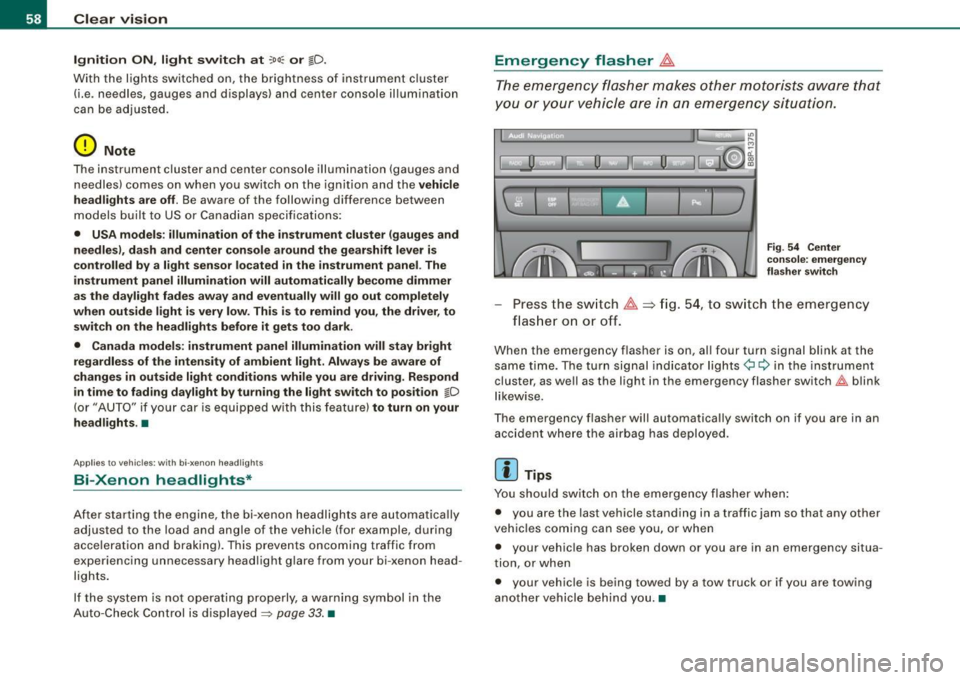
Clear vision
Igniti on ON , light swit ch at ::oo: or fD .
With the lights switched on, the brightness of instrument cluster
!i.e . needles, gauges and displays) and center console il lumination
can be adjusted.
0 Note
The instrument cluster and cent er console illumina tion (gauges and
needles) comes on when you swi tch on the igni tion and the
vehi cle
h eadlights are off .
Be aware of the following difference between
models built to US or Cana dian speci fica tions :
• USA model s: illumination of the in strument clu ster (gauges and
needle s), dash and center con sole around the gear shift lever i s
c o ntrolled by a light sensor lo cated in the instrument panel. The
i n strument panel ill umination will automatically become dimmer
a s th e daylight fades awa y and eventu ally w ill go out completel y
when outside l ight i s very low . Thi s is to remind you , the driver , to
swi tch on the headlight s befo re it get s to o dar k.
• Canada models: in strument panel illumination will stay bright
re gardle ss of the i ntens ity of ambient light . Al wa ys be aware of
change s in out sid e light conditi ons while you are d riving. Re spond
i n time t o fading daylight by turn ing the light swit ch to posit ion
fD
(or "AUTO" if your car is equipped with this feature) to turn on your
headlights . •
Ap plies to vehi cles: with b i-xeno n headli ghts
Bi-Xenon headlights*
After starting the engine, the bi -xenon headlights are automatica lly
adjus ted to the load and angle of the vehic le (for example , during
acce lerat ion and brak ing) . This prevents oncoming traffic fro m
experiencing unnecessary headlight g lare from your bi-xenon head
lights .
If the system is not operating properly, a warning symbol in the
Auto -Check Control is displayed ::::;,
page 33. •
Emergency flasher ~
The emergency flasher mak es othe r moto rists aware that
you or your vehicle are in an emergency situation.
1 1 Q
-
II D ll1
[ Ii J
a
l 'l
"' " "'
J
Fi g. 5 4 Cen ter
co nso le : em erge ncy
fl as her swi tc h
Press the sw itch ~==>fig. 54, to sw itch the emergency
flas her on or off.
When the emergency flasher is on, al l four turn signal blink at the
same time. The turn signal indicator lights¢ Q in the inst rument
cluster, as we ll as the light in the emergency flasher switch~ blink
l ikew ise.
The emergency flasher will automatically switch on if you are in an accident where the airbag has deployed .
[ i ] Tips
You should switch on the emergency flasher when :
• you are the last vehicle standing in a traffic jam so that any other
veh ic les coming can see you, or when
• your vehic le has broken down or you are in an emergency situa
tion, or when
• your vehicle is being towed by a tow truck or if you are towing
another vehicle behind you. •